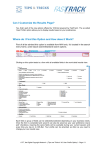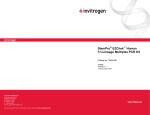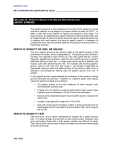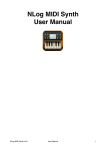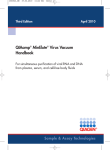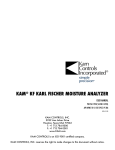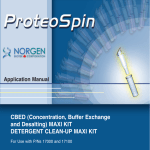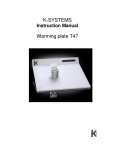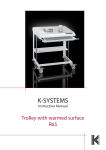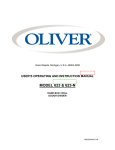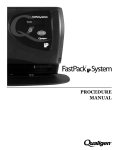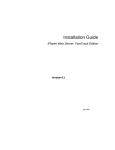Download FastTrack® Kit - Thermo Fisher Scientific
Transcript
FastTrack® 2.0 Kit For isolation of mRNA Catalog nos. K1593-02, K1593-03 Version K 4 December 2006 25-0099 Corporate Headquarters Invitrogen Corporation 1600 Faraday Avenue Carlsbad, CA 92008 T: 1 760 603 7200 F: 1 760 602 6500 E: [email protected] For country-specific contact information visit our web site at www.invitrogen.com User Manual ii Table of Contents Introduction ................................................................................................................................. 1 Overview ................................................................................................................................................................1 Materials.................................................................................................................................................................3 Methods ....................................................................................................................................... 5 Preparing Samples—General Information .............................................................................................................5 Preparing Samples—Tissue Culture Cells .............................................................................................................6 Preparing Samples—Fresh and Frozen Tissue.......................................................................................................7 Preparing Samples—Plants and Total RNA...........................................................................................................8 Basic mRNA Isolation Method ..............................................................................................................................9 Appendix.................................................................................................................................... 12 Troubleshooting and Product Qualification .........................................................................................................12 Technical Support ................................................................................................................................................13 References ............................................................................................................................................................14 iii iv Introduction Overview + Introduction The FastTrack® 2.0 mRNA Isolation Kit allows isolation of polyA RNA directly from 7 8 cells (1 x 10 -1 x 10 ), tissue (0.4-1.0 g), or total RNA (0.1-1.0 mg) in 2–3 hours using minimal equipment (water bath, centrifuge, microcentrifuge, and homogenizer), without the need for ultracentrifugation or guanidinium lysis. Typical Yields The FastTrack® 2.0 mRNA Isolation Kit yields the following amounts of mRNA: • • • 8 40-70 µg per 1x10 cultured insect cells 5-80 µg per gram of tissue 10-20 µg per milligram of total RNA. Yields of mRNA vary depending on the type of tissue and the stage of differentiation. Flow Chart of Process The following figure outlines the FastTrack® process. FastTrack® 2.0 Kit 1 x 107 - 1 x 108 Tissue Culture Cells or 0.4-1 gram Tissue Detergent lysis plus Proteinase K Batch binding with NaCl and oligo dT cellulose powder Low-salt wash Spin column elution mRNA for cDNA Synthesis, Oocyte Microinjection, Northerns, and RT-PCR Continued on next page 1 Overview, Continued The FastTrack® 2.0 mRNA Isolation Kit provides the following benefits: Benefits of the FastTrack® Kit Feature Complete kit with RNase-free solutions Ensures success in your laboratory No total RNA isolation necessary Saves considerable time Pre-measured, high-quality oligo(dT) cellulose powder Produces higher yields of mRNA over oligo(dT) tablets Efficient binding of mRNA to oligo(dT) cellulose Improves yield Minimal centrifugation/manipulation Reduces mRNA degradation and loss The FastTrack® 2.0 mRNA Isolation Kit is available in two sizes. Types of Kits Item Reactions Catalog no. ® 6 K1593-02 ® 18 (3 x 6) K1593-03 FastTrack 2.0 Kit FastTrack 2.0 Kit Micro-FastTrack Kit ™ The Micro-FastTrack™ mRNA Isolation Kit is also available from Invitrogen and allows 2 6 efficient mRNA isolation from small samples (1 x 10 -5 x 10 tissue culture cells, 10-200 mg tissue, or 100 µg total RNA). Item Reactions Catalog no. ™ 20 K1520-02 ™ 60 (3 x 20) K1520-03 Micro-FastTrack Kit Micro-FastTrack Kit Additional Products Benefit Additional kit reagent is available separately from Invitrogen. See the table below for ordering information. A large variety of RNA and DNA purification kits is available from Invitrogen. For details, visit www.invitrogen.com/naprep or contact Technical Support. Item Oligo dT Cellulose 2 Amount Catalog no. 1 gram R545-01 Materials Shipping/Storage The FastTrack® 2.0 mRNA Isolation Kit is shipped at room temperature. Upon receipt, store the kit at room temperature for up to six months. Remove the six tubes of premeasured oligo(dT) cellulose and store in a dessicator protected from light at room temperature as oligo(dT) cellulose is hydroscopic and sensitive to light. For long-term storage (>6 months), store the oligo(dT) cellulose at -20°C in a dessicator protected from light. The Proteinase K solution is stable for 1 year when stored at room temperature. For long-term storage (>1 year) or if room temperature is >25ºC, store the Proteinase K solution at 4ºC. Kit Contents The FastTrack® 2.0 mRNA Isolation Kit contents are listed below for K1593-02 (6 reactions). The kit for 18 reactions (K1593-03) contains three times the amount of reagents listed in the table below. Item Stock Buffer Quantity 100 ml Composition 200 mM NaCl 200 mM Tris-HCl, pH 7.5 1.5 mM MgCl2 2% SDS Proteinase K (20 mg/ml in storage buffer) 2 x 1.25 ml Proprietary Binding Buffer 2 x 110 ml 500 mM NaCl (220 ml) 10 mM Tris-HCl, pH 7.5 in DEPC-treated water Low Salt Wash Buffer Quick Reference Card 3 x 100 ml 250 mM NaCl (300 ml) 10 mM Tris-HCl, pH 7.5 in DEPC-treated water Elution Buffer 2 x 8 ml 10 mM Tris-HCl, pH 7.5 in DEPC-treated water 2 M Sodium Acetate 4 ml 2 M Sodium Acetate, pH 5.2 in DEPC-treated water 5 M NaCl 8 ml 5 M NaCl in DEPC-treated water Pre-measured Oligo(dT) 2030 Cellulose Powder 6 x 75 mg Lyophilized oligo(dT) cellulose Microcentrifuge Tubes with Disposable Spin Columns 6 each — Microcentrifuge Tubes 6 each — Also included in this kit is a Quick Reference Card that can be used as a checklist. Each step can be conveniently marked with a laboratory marker pen to keep track of steps. Marks may be removed with ethanol before the next use. Continued on next page 3 Materials, Continued Materials Supplied Solutions by User • Phosphate-Buffered Saline (PBS) to wash tissue culture cells (see page 6) • 100% ethanol • 70% ethanol Equipment 4 • Sterile 50 ml cell culture centrifuge tubes • Water baths (45°C, 65°C) • Liquid nitrogen (tissues) • Sterile knife (tissues) • 15-20 cc syringes with 18-21 gauge needles • Motor-driven homogenizer for tissues (Tissuemizer or Omni Mixer) • Table-top centrifuge • Rocking platform or rotating wheel • Mortar, pestle and 50 ml Dounce Homogenizer (tissues–optional) Methods Preparing Samples—General Information Introduction Review this section carefully before starting and familiarize yourself with the basic mRNA isolation protocol on page 9. The method of sample preparation depends on whether your sample is tissue culture cells, tissues (including plants), or total RNA. The lysate or total RNA solution you produce in this section is then used directly for mRNA isolation. Once you lyse your sample, do not stop until the mRNA is in ethanol (see Elution and Precipitation of the mRNA, Step 6, page 10). General Handling of RNA When working with RNA: • Use disposable, individually wrapped, sterile plasticware. • • Use only sterile, new pipette tips and microcentrifuge tubes. Glassware used for RNA work should be cleaned with detergent, thoroughly rinsed, autoclaved, then oven baked at >210°C for at least three hours before use. Wear latex gloves while handling reagents and RNA samples to prevent RNase contamination from the surface of the skin. Always use proper microbiological aseptic technique when working with RNA. • • You may use RNase AWAY™ Reagent, a non-toxic solution available from Invitrogen (Catalog no. 10328-011) to remove RNase contamination from surfaces. For further information on controlling RNase contamination, see Ausubel, et al., 1990, or Sambrook, et al., 1989. MEND Prepare the FastTrack® 2.0 Lysis Buffer immediately before. Follow the instructions below to prepare the Lysis Buffer. 1. Check the Stock Buffer for a white precipitate (SDS). If the Stock Buffer has a white precipitate, heat the solution to 65°C until dissolved. Cool the solution to room temperature prior to adding the Proteinase K. 2. Add 300 µl Proteinase K to 15 ml Stock Buffer for each intended isolation. Use immediately. • If you are isolating polyA+ RNA from yeast cells, note that the yield of polyA+ RNA is likely to be lower than the yields obtained with other eukaryotic cells. Yeast cells generally yield lower amounts of polyA+ RNA than other eukaryotic cells because: ION AT RECOM Preparing Lysis Buffer • Yeast mRNAs contain shorter polyA+ tails • Yeast cells are harder to lyse • To increase the yield of polyA+ RNA, we recommend preparing total yeast RNA using PureLink™ Micro-to-Midi Total RNA Purification System (Catalog. no. 12183018). • When binding to oligo(dT) cellulose, we recommend that you increase the incubation time of your RNA with oligo(dT) cellulose to at least 1 hour. Increasing the incubation time of yeast RNA with the oligo(dT) cellulose may increase the binding efficiency. 5 Preparing Samples—Tissue Culture Cells Preparing Tissue Cultured Cells 6 7 8 We recommend using 1 x 10 -1 x 10 cells for each mRNA isolation. 1. Wash the cells in 4°C phosphate buffered saline (PBS) solution (available from Invitrogen, visit www.invitrogen.com for details). 2. Transfer the cells to a 50 ml sterile centrifuge tube. Pellet the cells and continue with Step 3, or flash freeze the pellet in liquid nitrogen and store at -80°C. 3. Resuspend and lyse the cells by adding 15 ml FastTrack® 2.0 Lysis Buffer (page 5) to the cell pellet. If the pellet was frozen and does not thaw quickly, place the tube with the cells and buffer in a 45°C water bath for 1-2 minutes. Vortex to completely resuspend the cells. 4. Pass the lysate 2–4 times through a sterile syringe fitted with a 18–21-gauge needle. Proceed to the Basic mRNA Isolation Method, Step 1, page 9. Preparing Samples—Fresh and Frozen Tissue Preparing Tissue for Storage To achieve high yields of mRNA from plant, insect, or mammalian tissues, use ~0.51 gram of tissue per isolation. Perform all lysis and washing steps to ensure consistently high yields. See page 8 for plant tissue preparation. 1. Quickly excise the tissue, cut into pieces of 1-2 cm2 with a sterile knife or razor blade, and immediately freeze in liquid nitrogen. 2. Store the tissue at -80°C in a polypropylene tube with a screw cap. Frozen tissue is stable at -80°C for over 1 year. Proceed to Preparing of Fresh or Frozen Tissue, below. Preparing Fresh or Thaw and homogenize the frozen tissue in the presence of lysis buffer to ensure immediate inactivation of any RNases that are released as the cells lyse. Complete Frozen Tissue homogenization is critical for complete cell lysis and inactivation of RNases. Be sure to clean and wash the homogenizer tip, then autoclave and bake for 3 hours or overnight at 210°C. Alternative Procedure 1. Place ~1 g fresh or frozen tissue in a preweighed, sterile, 50 ml centrifuge tube and weigh. Add 15 ml FastTrack® 2.0 Lysis Buffer containing Proteinase K (page 5). 2. Quickly homogenize the tissue using a motor-driven homogenizer such as Tissuemizer (Teckmar) or Omni Mixer Homogenizer (Omni International). Start at a low speed and slowly increase speed until a smooth homogenate with no visible particulate matter is obtained (~15-30 seconds). Keep foaming to a minimum by adjusting the speed. 3. Proceed to the Basic mRNA Isolation Method, Step 1, page 9. If a motor-driven homogenizer is not available, tissues may be homogenized using a mortar and pestle, and a Dounce homogenizer. Be sure to clean the equipment, then autoclave and bake before use. 1. Weigh out ~1 g of fresh or frozen tissue and place into a mortar precooled with liquid nitrogen. Cover the tissue with more liquid nitrogen and grind with a pestle until a fine powder is obtained. Add more liquid nitrogen as needed to keep the tissue covered with liquid nitrogen while grinding. 2. Transfer the suspension of liquid nitrogen and crushed tissue into a sterile 50 ml centrifuge tube containing 15 ml FastTrack® 2.0 Lysis Buffer containing Proteinase K (page 5). 3. Transfer to a sterile Dounce homogenizer at room temperature. Homogenize with 10-12 strokes. Proceed to the Basic mRNA Isolation Method, Step 1, page 9. 7 Preparing Samples—Plants and Total RNA Plant Tissue Plant tissue may need to be ground with a mortar and pestle in liquid nitrogen, then homogenized with a motor-driven homogenizer to improve cell breakage. 1. Harvest ~1-2 g plant tissue and quickly freeze in liquid nitrogen. 2. Place tissue in a mortar precooled with liquid nitrogen. Cover the tissue with more liquid nitrogen and grind with a pestle until a fine powder is obtained. Add more liquid nitrogen as needed to keep the tissue covered with liquid nitrogen while grinding. 3. Transfer tissue and liquid nitrogen to a sterile, 50 ml centrifuge tube. As soon as liquid nitrogen evaporates, add 15 ml FastTrack® 2.0 Lysis Buffer with Proteinase K (page 5). 4. Quickly homogenize the tissue using a motor-driven homogenizer or a Dounce homogenizer until a smooth homogenate with no visible particulate matter is obtained (~15-30 seconds). Keep foaming to a minimum by adjusting the speed. 5. Proceed to the Basic mRNA Isolation Method, Step 1, page 9. mRNA Isolation from Total RNA The 75 mg aliquot of oligo(dT) cellulose binds ~75 µg polyA RNA. Assuming total + RNA is 1-5% polyA , we recommend that you start with 1.0 mg of total RNA per mRNA isolation. 8 + 1. Ethanol precipitate total RNA and wash with 80% ethanol. 2. Resuspend the pellet in 100 µl of Elution Buffer. 3. Add the RNA solution to 10 ml FastTrack® 2.0 Lysis Buffer (page 5) in a sterile, 50 ml centrifuge tube. 4. Heat to 65°C for 5 minutes, then place immediately on ice for exactly 1 minute. 5. Place the tube at room temperature and add 650 µl 5 M NaCl and mix by gentle inversion. 6. Proceed to Step 4 of the Basic mRNA Isolation Method, page 9. Basic mRNA Isolation Method Introduction + A typical mammalian cell contains about 10-11 g of RNA, of which 1-5% is polyA RNA. The remaining RNA is mostly rRNA (80-85% of total) and low-molecular weight RNAs such as tRNA (15-20% of total). To separate the heterogeneous population of mRNA from the majority of the RNA found in the cell, affinity binding to oligo(dT) cellulose is used. This method exploits the major characteristic of mRNA, polyadenylation, to obtain intact, pure mRNA. The procedure described below is designed to remove DNA and proteins from your sample and allows selective binding of mRNA under high salt conditions to oligo(dT) cellulose. The resin is then transferred to a microcentrifuge spin column, and the rRNA is removed by washing the resin with a low salt buffer. The mRNA is then eluted with a very low ionic strength buffer. Intact, pure mRNA is isolated due to the: • Gentle lysis of cells • Efficient inactivation of RNases • Specificity of the oligo(dT) cellulose • Minimal handling of the mRNA sample. + The capacity of the oligo(dT) cellulose is ~1 µg polyA RNA per mg of resin. Before Starting Isolating mRNA • Equilibrate a water bath to 45°C • Obtain dry ice for mRNA precipitation 1. Incubate the cell lysate produced in the sample prep procedures (pages 6–8) at 45°C for 15-60 minutes. If insoluble material persists, centrifuge at 4,000 x g for 5 minutes at room temperature and transfer the supernatant to a new tube. Incubation is important for complete digestion of proteins and ribonucleases. A 60 minute incubation is recommended for tissues, while cell material is effectively digested with a 15 minute incubation. You may wish to optimize the time of incubation for your particular sample. 2. Adjust the NaCl concentration of the lysate to 0.5 M final concentration by adding 950 µl of the 5 M NaCl stock solution to each 15 ml lysate containing 0.2 M NaCl. Mix thoroughly by inversion. 3. Shear any remaining DNA by passing the lysate 3 to 4 times through a sterile plastic syringe fitted with an 18-21 gauge needle. This yields a cleaner mRNA preparation. If solution is viscous, see Troubleshooting on page 12. 4. Remove a vial of oligo(dT) cellulose from the dessicator and add the contents of the vial to the lysate. 5. Seal the tube and allow the oligo(dT) cellulose to swell for 2 minutes. The oligo(dT) cellulose should disperse readily. 6. Rock the tube gently at room temperature for 15 to 60 minutes. Rocking or rotating increases the efficiency of mRNA binding to oligo(dT) cellulose. 7. Pellet the oligo(dT) cellulose at 3,000 x g in a centrifuge for 5 minutes at room temperature. Remove the supernatant carefully from the resin bed. Proceed to the washing procedure, next page. Continued on next page 9 Basic mRNA Isolation Method, Continued Washing Oligo(dT) 1. Resuspend the oligo(dT) cellulose in 20 ml Binding Buffer. Centrifuge at 3,000 x g in a centrifuge for 5 minutes at room temperature. Remove the Binding Buffer from Cellulose the resin bed. 2. Resuspend the resin in 10 ml Binding Buffer and centrifuge as in Step 1. Remove the buffer from the resin bed. 3. Resuspend the resin in 10 ml Low Salt Wash Buffer and centrifuge as in Step 1. This low salt wash removes SDS and contaminating RNAs such as rRNAs. 4. Repeat Step 3 until the buffer no longer has any bubbles after centrifugation (at least 2–4 times). After the last wash, resuspend the oligo(dT) cellulose in Low Salt Wash Buffer at a final volume of 800 µl. 5. Transfer the oligo(dT) cellulose into a spin-column (inside the spin-column/microcentrifuge set) to perform the last washing steps. Centrifuge at 5,000 x g for 10 seconds at room temperature. 6. Remove the column from microcentrifuge tube and decant the liquid inside the tube. Repeat Steps 5 and 6 as many times as necessary (~2-3 times) to transfer the oligo(dT) to the spin column. 7. To wash, place the spin-column back into the tube, fill the tube to the top with Low Salt Wash Buffer (~500 µl) and mix the buffer into the cellulose bed with a sterile pipette tip. Centrifuge for 10 seconds. 8. Repeat Step 7 at least 3 times or until the OD260 of the “flow-through” is < 0.05. Be sure to mix the buffer into the cellulose bed. 1. Place the spin-column into a new (sterile and RNase-free) microcentrifuge tube provided in the kit. 2. Add 200 µl Elution Buffer and mix the buffer into the cellulose bed with a sterile pipette tip. 3. Centrifuge for 30 seconds, but DO NOT decant the liquid. The mRNA is now in the eluate. 4. Add a second 200 µl of Elution Buffer to the column, mix into the cellulose, and centrifuge again for 30 seconds. Be careful not to damage the membrane as you will lose the resin (and your sample). Elution and Precipitation of the mRNA Steps 2 through 4 elutes the mRNA into the microcentrifuge tube. 5. Remove the column from the tube. The tube now contains 400 µl. Do Not Discard. This is your mRNA sample. 6. Precipitate the mRNA with 0.15 volume (~60 µl) of 2 M sodium acetate (supplied) and 2.5 volume (1 ml) of 200 proof (100%) ethanol. Place on dry ice for 10-15 minutes. 7. Centrifuge in a microcentrifuge at maximum speed for 15 minutes at 4°C. Carefully remove the supernatant and discard it without disturbing the pellet. 8. Wash the pellet with 70% ethanol. Centrifuge again to collect any residual ethanol. 9. Remove the ethanol. Centrifuge briefly and remove traces of ethanol. Air-dry the pellet for 5–10 minutes. Resuspend the RNA pellet in 20-50 µl of Elution Buffer (10 mM Tris, pH 7.5). 10. Determine the concentration of the mRNA (see next page). The mRNA may be used immediately or stored indefinitely at -80°C. 10 Basic mRNA Isolation Method, Continued Determining RNA Yield To determine the concentration of the resuspended RNA, dilute the sample 100 fold by adding 4 µl of sample to 396 µl of Elution Buffer. Use Elution Buffer to blank the spectrophotometer at 260 nm. Place the diluted sample into a 500 µl quartz cuvette and read the absorbance at 260 nm. Determine the RNA concentration by using the following formula: [RNA] = (A260) (0.04 µg/µl) D D is the dilution factor (D = 100 in the above example). Determine the RNA yield by multiplying the concentration by the volume of the RNA. Note that the A260 must be > 0.05 to give an accurate RNA concentration. FastTrack® 2.0 Quick Reference Card If you routinely use the FastTrack® 2.0 mRNA Isolation Kit, you may wish to use our laminated Quick Reference Card as a checklist. Each step can be conveniently marked to keep track of centrifugations, transfers, and washes. Use a laboratory marker pen to check off items and wipe off with ethanol to reuse. 11 Appendix Troubleshooting and Product Qualification Troubleshooting The table below describes solutions to possible problems you might encounter. If you need assistance at any time, contact the Invitrogen Technical Support (see next page). Problem Low yields of mRNA Reason Solution Proteinase K depleted because large amounts of protein in the sample compete out RNase Reduce amount of starting material. mRNA is not completely eluted off oligo(dT) cellulose Perform another set of elutions. Heat the elution buffer to 65°C and pass over the column. Ruptured membrane in spin Be careful when resuspending oligo(dT) column (loss of oligo(dT) cellulose. cellulose) mRNA is contaminated with rRNA Poor removal of rRNA during Low Salt Wash Mix the Wash buffers gently into the oligo(dT) cellulose with the pipette tip. Viscous lysate Sample too large Add 15 ml more of FastTrack® 2.0 Lysis Buffer and process as 2 samples Remember to use 2 spin-columns and 2 aliquots of oligo(dT) cellulose. (mRNA will bind to oligo(dT) cellulose if the viscosity is reduced) Large amounts of DNA Product Qualification 12 Split the sample as above and shear with a 21 gauge needle. Each kit component is sterile and free of ribonuclease contamination and has been lot qualified for optimum performance in the FastTrack® 2.0 mRNA Isolation Kit. We do not recommend substituting your own reagents for any of the reagents supplied with the kit. Technical Support World Wide Web Contact us Visit the Invitrogen website at www.invitrogen.com for: • Technical resources, including manuals, vector maps and sequences, application notes, MSDSs, FAQs, formulations, citations, handbooks, etc. • Complete technical support contact information • Access to the Invitrogen Online Catalog • Additional product information and special offers For more information or technical assistance, call, write, fax, or email. Additional international offices are listed on our web page (www.invitrogen.com). Corporate Headquarters: Invitrogen Corporation 1600 Faraday Avenue Carlsbad, CA 92008 USA Tel: 1 760 603 7200 Tel (Toll Free): 1 800 955 6288 Fax: 1 760 602 6500 E-mail: [email protected] Japanese Headquarters: Invitrogen Japan LOOP-X Bldg. 6F 3-9-15, Kaigan Minato-ku, Tokyo 108-0022 Tel: 81 3 5730 6509 Fax: 81 3 5730 6519 E-mail: [email protected] European Headquarters: Invitrogen Ltd Inchinnan Business Park 3 Fountain Drive Paisley PA4 9RF, UK Tel: +44 (0) 141 814 6100 Tech Fax: +44 (0) 141 814 6117 E-mail: [email protected] MSDS Requests MSDSs (Material Safety Data Sheets) are available on our website at www.invitrogen.com/msds. Limited Warranty Invitrogen is committed to providing our customers with high-quality goods and services. Our goal is to ensure that every customer is 100% satisfied with our products and our service. If you should have any questions or concerns about an Invitrogen product or service, contact our Technical Support Representatives. Invitrogen warrants that all of its products will perform according to specifications stated on the certificate of analysis. The company will replace, free of charge, any product that does not meet those specifications. This warranty limits Invitrogen Corporation’s liability only to the cost of the product. No warranty is granted for products beyond their listed expiration date. No warranty is applicable unless all product components are stored in accordance with instructions. Invitrogen reserves the right to select the method(s) used to analyze a product unless Invitrogen agrees to a specified method in writing prior to acceptance of the order. Invitrogen makes every effort to ensure the accuracy of its publications, but realizes that the occasional typographical or other error is inevitable. Therefore Invitrogen makes no warranty of any kind regarding the contents of any publications or documentation. If you discover an error in any of our publications, report it to our Technical Support Representatives. Invitrogen assumes no responsibility or liability for any special, incidental, indirect or consequential loss or damage whatsoever. The above limited warranty is sole and exclusive. No other warranty is made, whether expressed or implied, including any warranty of merchantability or fitness for a particular purpose. 13 References Ausubel, F. M., Brent, R., Kingston, R. E., Moore, D. D., Seidman, J. G., Smith, J. A., and Struhl, K. (Ed.). (1990) Current Protocols in Molecular Biology, Greene Publishing Associates and Wiley-Interscience, New York. Sambrook, J., Fritsch, E. F., Maniatis, T. (1989) Molecular Cloning: A Laboratory Manual, Cold Spring Harbor Laboratory, 2nd edition. For FastTrack® Kit citations, visit our citation database on www.invitrogen.com. ©1999-2006 Invitrogen Corporation. All rights reserved. For research use only. Not intended for any animal or human therapeutic or diagnostic use. 14 Corporate Headquarters Invitrogen Corporation 1600 Faraday Avenue Carlsbad, CA 92008 T: 1 760 603 7200 F: 1 760 602 6500 E: [email protected] For country-specific contact information visit our web site at www.invitrogen.com User Manual




















